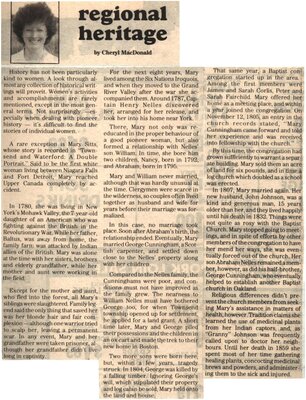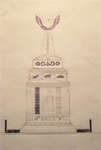"Regional Heritage"
- Full Text
- regional heritageby Cheryl MacDonald
History has not been particularly kind to women. A look through almost any collection of historical writings will proveit. Women's activities and accomplishments are rarely mentioned, except in the most general terms. Not surprisingly - especially when dealing with pioneer history - it's difficult to find the stories of individual women.
A rare exception is Mary Sitts, whose story is recorded in "Townsend and Waterford: A Double Portrait." Said to be the first white woman living between Niagara Falls and Fort Detroit, Mary reached Upper Canada completely by accident.
In 1780, she was living in New York's Mohawk Valley, the 7-year-old daughter of an American who was fighting against the British in the Revolutionary War. While her father, Baltus, was away from home, the family farm was attacked by Indian allies of the British. Mary was alone at the time with her sisters, brothers and elderly grandfather, while her mother and aunt were working in the field.
Except for the mother and aunt, who fled into the forest, all Mary's siblings were slaughtered. Family legend said the only thing that saved her was her blonde hair and fair complexion - although one warrior tried to scalp her, leaving a permanent scar. In any event, Mary and her grandfather were taken prisoner, although her grandfather didn't live long in captivity.
For the next eight years, Mary lived among the Six Nations Iroquois, and when they moved to the Grand River Valley after the war she accompanied them. Around 1787, Captain Henry Nelles discovered her, arranged for her release, and took her into his home near York.
There, Mary not only was re-educated in the proper behaviour of a good pioneer woman, but also formed a relationship with Nelles' son Williams. In time, she bore him two children, Nancy, born in 1792, and Abraham, born in 1795.
Mary and William never married, although that was hardly unusual at the time. Clergymen were scarce in the wilderness, so couples often lived together as husband and wife for years before their marriage was formalized.
In this case, no marriage took place. Soon after Abraham's birth, the relationship ended. Eventually, Mary married George Cunningham, a Scottish carpenter, and settled down close to the Nelles' property along with her children.
Compared to the Nelles family, the Cunninghams were poor, and conditions must not have improved as the family grew. The nearness to William Nelles must have bothered George too, for when Townsend township opened up for settlement, he applied for a land grant. A short time later, Mary and George piled their possessions and the children in an ox cart and made the trek to their new home in Boston.
Two more sons were born here, but, within a few years, tragedy struck. In 1804, George was killed by a falling timber. Ignoring George's will, which stipulated their property and log cabin be sold; Mary held onto the land and house.
That same year, a Baptist congregation started up in the area. Among the first members were James and Sarah Corlis, Peter and Sarah Fairchild. Mary offered her home as a meeting place, and within a year joined the congregation. On November 12, 1805, an entry in the church records stated, "Mary Cunningham came forward and told her experience and was received into fellowship with the church."
By this time, the congregation had grown sufficiently to warrant a separate building. Mary sold them an acre of land for six pounds, and in time a log church which doubled as a school was erected.
In 1807, Mary married again. Her new husband, John Johnson, was a kind and generous man, 15 years older than her, and they lived happily until his death in 1832. Things were not quite as rosy with the Baptist Church. Mary stopped going to meetings, and in spite of efforts by other members of the congregation to have her mend her ways, she was eventually forced out of the church. Her son Abraham Nelles remained a member, however, as did his half-brother, George Cunningham, who eventually helped to establish another Baptist church in Oakland.
Religious differences didn't prevent the church members from seeking Mary's assistance in matters of health, however. Tradition claims she learned the use of medicinal plants from her Indian captors, and, as "Granny" Johnson was frequently called upon to doctor her neighbours. Until her death in 1859 she spent most of her time gathering healing plants, concocting medicinal brews and powders, and administering them to the sick and injured.
- Creator
- MacDonald, Cheryl, Author
- Media Type
- Newspaper
- Item Types
- Articles
- Clippings
- Description
- "History has not been particularly kind to women. A look through almost any collection of historical writings will prove it. Women's activities and accomplishments are rarely mentioned, except in the most general terms. Not surprisingly-especially when dealing with pioneer history-it's difficult to find the stories of individual women."
- Subject(s)
- Personal Name(s)
- Sitts, Mary ; Nelles, Henry ; Nelles, William ; William, Nancy ; William, Abraham ; Cunningham, George ; Corlis, James ; Corlis, Sarah ; Fairchild, Peter ; Fairchild, Sarah ; Johnson, John.
- Local identifier
- SNPL002579v00d
- Collection
- Scrapbook #1 by Janet Heaslip
- Language of Item
- English
- Geographic Coverage
-
-
Ontario, Canada
Latitude: 43.06681 Longitude: -80.11635
-
- Creative Commons licence
 [more details]
[more details]- Copyright Statement
- Public domain: Copyright has expired according to Canadian law. No restrictions on use.
- Contact
- Six Nations Public LibraryEmail:info@snpl.ca
Website:
Agency street/mail address:1679 Chiefswood Rd
PO Box 149
Ohsweken, ON N0A 1M0
519-445-2954




